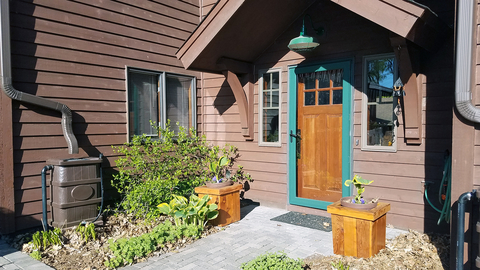Quick facts
- Collecting water in rain barrels is a good way to reduce run-off into streets and waterways.
- Water from rain barrels is not drinkable (non-potable) and generally should not be used to irrigate or wash edible plants like vegetables, fruits, greens and edible flowers.
- Water from rain barrels is a good choice for irrigating ornamental plants.
- Rain barrels must be cleaned and maintained to prevent algae from clogging the water outlet.
The benefits of using a rain barrel
- Reduce run-off and erosion on your property.
- Provide an alternative water source for landscape plants.
- Reduce use of municipal water to water plants, which may lower your water bill.
- Rainwater is slightly acidic and may contain minerals that benefit plants.
How to use rain barrel water
Water collected in a rain barrel is not considered a potable water source, meaning it is not drinkable and has not been tested to meet microbial water quality standards to protect public health. Because the water from a rain barrel is not potable, it should NOT touch the edible part of any plant such as greens, fruit, root vegetables, herbs and edible flowers.
Municipal and well-water sources are tested to make sure they are free from detectable levels of harmful pathogens like E. coli and other fecal pathogens that can make people sick if ingested.
Water from a rain barrel may have fecal contamination from roofs or from wherever it has been collected. Roofing materials may also contain heavy metals and chemical contaminants that can be dangerous to ingest.
How to safely use rain barrel water to water plants
There is no way to see or smell contamination without getting rain barrel water tested, which would need to be done so frequently that it would be too expensive for most home or community gardens. So, it is best to minimize risk with this water by using it only on non-edible, ornamental plants like flowers, shrubs and indoor plants.
If you can apply rain barrel water in a way that ensures that the water does not touch the edible portion of the plant, you could use it to water tall berry bushes, trellised plants like tomatoes, melons and cucumber, and on fruit trees.
Rain barrel water is a good option for watering your houseplants. Some indoor plants like orchids and plants with long narrow leaves are sensitive to tap water that is softened and contains additives like chloride and fluoride.
The best way to water plants
Best practices for watering plants apply to all water sources.
- Water the base of the plant where the roots are located and don't splash on the fruit.
- Drip irrigation, soaker hoses, low emitters and hand-watering work best.
- If using rain barrel water, water by hand.
- Avoid watering plants overhead and with overhead sprinklers.
- Water on leaves can encourage leaf spot diseases.
- Overhead water can splash soil-borne pathogens (bacteria, fungi) onto plant leaves and cause plant diseases.
For more information, see Watering the vegetable garden and Water Wisely.
Installing and maintaining a rain barrel
- Rain barrels for home garden use are available in a variety of materials, shapes, designs and colors. You can also find plans online to build a rain barrel.
- Rain barrels can be a strong accent or focal point in a garden, so choose one that is functional, can be maintained and fits your landscape style.
- Most rain barrels hold 50-55 gallons of water.
- Rain barrels usually come with a water outlet and hose, an overflow outlet, and a screen to prevent debris and small animals from falling into the barrel.
- Rain barrels can be used in conjunction with a rain garden as an overflow basin.
Installing a rain barrel
Check the packing slip to make sure that your rain barrel comes with a hose system, overflow tube and screen. Contact your supplier if you are missing a part.
- Position your rain barrel under a drain spout, so that run-off from the roof will go directly into the rain barrel.
- You will probably want to raise your rain barrel using blocks or wood so you can drain as much of the water as possible or fit a watering can under the spigot.
- Install the screen to catch any debris such as seeds, leaves, sticks, etc.
- Install the overflow. This will prevent your rain barrel from overflowing.
- An overflow can be directed into a garden bed, base of a tree, or other areas away from buildings.
Maintaining a rain barrel
Fall is a good time to clean your rain barrel. Rain barrels should be stored in a garage or shed or outside.
- Drain the barrel completely.
- Remove any debris in the barrel.
- Use a long-handled brush to scrub the inside of the barrel with water and detergent. Rinse with clean water.
- Store your rain barrel upside down or covered over the winter. Remove the hose and screen and store them in a garage or shed. Make sure your rain barrel is empty as any water left in the barrel may freeze, expand and crack your rain barrel.
Without a rain barrel in place, you’ll want to attach a temporary extension to your downspout to direct any snowmelt or early rains away from your house and sidewalks.
Reviewed in 2024


